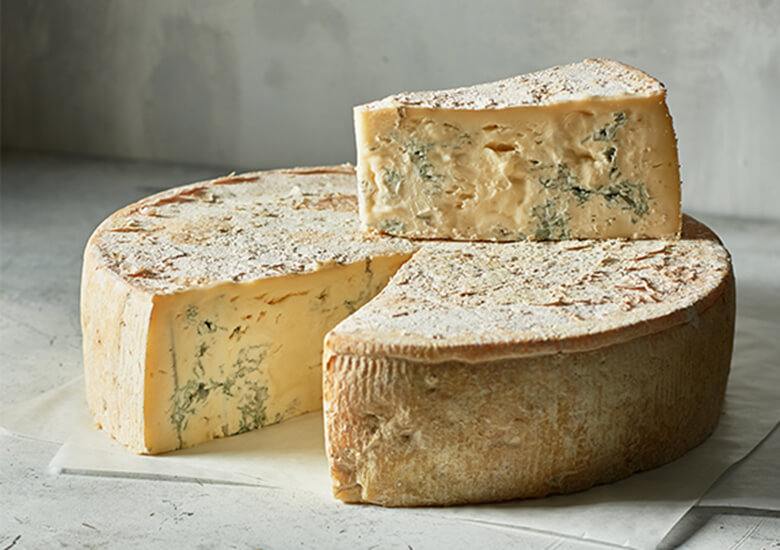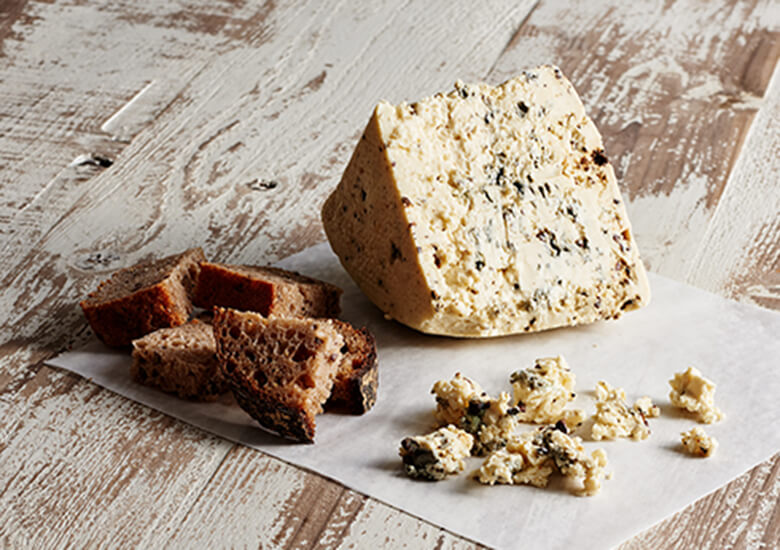Few cheeses inspire the kind of passionate response that a mere mention of blue cheese does. From those who say, “I just don’t like blue cheese,” to those who couldn’t live without a regular serving of their favorite creamy blue at every meal, everyone has an opinion to share.
Whatever camp you fall into (or if you’re just not sure yet!) we hope this guide to good-ole blue will inspire you to expand your horizons and appreciate what makes this funky cheese so special.
Cheese History: The story behind blue cheese

The origins of blue cheese are shrouded in legend and myth. The most popular genesis story transports us to a cave near the village of Roquefort, France in the 7th century where a young shepherd abandoned his half-eaten lunch of bread and cheese after being distracted by a beautiful maiden. Upon returning to this cave a few months later, he discovered his leftover cheese had been covered with the famous blue mold we know now as Penicillium roqueforti.
While this story certainly inspires the cheese-loving romantic in us, researchers have their doubts about its accuracy. For one, scientists have yet to find naturally-occurring P. roqueforti in caves or cellars. Additionally, blue’s classic veining generally comes from the growth of mold inside the cheese—mold that grew on the outside would be unlikely to create anything similar to the blue we recognize today.
So how was blue cheese actually created? No one can say for certain. The best evidence available around the legendary tale is that P. roqueforti, like many microbes, occurs naturally in the environment and tends to grow prolifically on grains. This leads us to infer that either the milk used for the cheese or the grains of rye in the bread contained spores of P. roqueforti. This makes sense, as many early cheesemakers used spores from moldy rye bread to craft their blue cheese.
Cheese Science: The molds behind blue cheese

As we talked about in our guide to cheese tasting, cheese is a made up of living, breathing natural microorganisms that help create the flavors we know and love. In the case of blue cheese, the fungi Penicillium roqueforti is what creates the distinctive smell, flavor, and blue veins.
So, do all blue cheeses that use P. roqueforti taste the same? Of course not! There are several well-known species of Pencillium fungi used in the making of blue cheese, including P. roqueforti and P. glaucum. P. glaucum is most commonly associated with Gorgonzola and typically has a greener appearance. Some blue cheeses even use both strains. Additionally, it’s unlikely that any two blue cheeses will taste alike, even if they used identical samples of P. roqueforti.
Both P. roqueforti and P. glaucum are closely related to the white powdery molds that colonize brie styles of cheeses. These aerobic molds need oxygen to thrive, and the cheese is pierced as part of the aging process in order to allow oxygen into the wheels. This results in the distinctive veining that is typical with blue cheese.
All about blue cheese

Are there different types of blue cheese?
You bet! From crumbly to creamy and everything in between, there are countless varieties of blue cheese to try. We’d venture to guess that most people who claim they don’t like blue cheese just haven’t tried the right blue cheese for their palate yet.
Crumbly blue cheeses tend to be more piquant than their creamy counterparts and can be overwhelming to someone taking their first bites of blue. If you’re new to blue, try a creamy, milder variety to acclimate your palate. If you’re wondering what other types of moldy cheese are out there, our guide to moldy cheese is a great starting point.
Must-try Wisconsin blue cheeses
Roth Buttermilk Blue: Rich, creamy, and delightfully tangy, this blue from Roth Cheese is a sterling example of a mild and easy-going blue that turns blue skeptics into lovers.
Deer Creek The Blue Jay: What happens when you add five 10-gallon containers of cream to each batch of cheese? Answer: The Blue Jay made by Deer Creek Cheese. This cheese manages to be bold and unapologetically blue while still maintaining an impossibly creamy and smooth finish—thanks to the quintuple serving of cream added to each batch. The Blue Jay is also infused with crushed juniper berries that complement blue’s natural earthiness with some botanical flavor.
Hook’s Original Blue: If we could only pick one cheese to represent the essence of blue, this cheese from Hook’s Cheese Company would be high on our list. Aged for just over 12 months, this blue strikes a perfect balance, boasting a strong yet approachable flavor with just a touch of sweetness.
Carr Valley Glacier Penta Creme: This three-time award winner from Carr Valley is another decadent five-crème blue pioneered by Master Cheesemaker Sid Cook. The generous addition of cream makes this cheese incredibly smooth while embracing the barnyard-y goodness that makes blue famous.
What does blue cheese taste like?
Relative to other cheeses like cheddar, even mild blues can pack quite a strong flavor profile. Most blue cheeses will taste salty, bright, and a bit funky or earthy. Unlike a mild cheese such as Colby, blue has a flavor that likes to be front-and-center in any dish or pairing. There’s no mistaking the taste of blue!
What gives blue cheese its flavor?
Blue cheese's distinct and often earthy flavor comes from the intentionally introduced fungi, Penicillium roqueforti. This mold breaks down some of the fat within the cheese, turning it into different compounds that change the flavor and aroma of the cheese.
Although this mold plays a key role in the taste of blue cheese, there are countless other factors that influence the taste of blue cheese. Cheesemakers can use milk from different seasons, change how the cheese is aged, and more to create entirely unique blue cheeses.
Pairing blue cheese

While the prospect of pairing a big, bold blue might be intimidating, there are a surprising number of drinks that are great partners.
What beer goes well with blue cheese?
Time to break out your favorite IPAs! We’d recommend starting with something hazy and fruity such as a New England IPA. The bitter, hoppy notes cut through the fatty mouthfeel of the cheese, while the fruity finish contrasts wonderfully with the grassy, earthy flavor of the blue. You can scale this pairing with the intensity of the cheese. A more intense, aged blue will require a stronger beer to match.
What wine pairs best with blue cheese?
We turn to bold, fruity wines when pairing wine with blue cheese. Think zinfandel or Malbec if you enjoy red wines, or sweet Bordeaux-style wines if you prefer white wine. For more intense varieties of blue, we recommend turning up the sweetness with a dessert wine like port.
What spirits should I have with blue cheese?
For higher proof pairings, a bottle of tequila reposado or tequila añejo is always a good option for pairing with blue cheese. Botanical liquors like gin also play well with blue. In particular, Deer Creek’s The Blue Jay goes spectacularly with an elderflower infused gin.
If you’re ready to take a deeper look into the world of cheese pairing, we recommend starting with our beginner’s guide to cheese pairing.
Time to get the blues!
If all this talk of cheese has gotten you hungry for a cheese tasting, you can get Wisconsin’s finest blue cheeses delivered right to your door with our continuously updated list of cheesemakers and retailers that allow you to order cheese online. Award-winning Wisconsin cheese is just a click away.
Craving something else? Choose from our selection of over 300 recipes featuring Wisconsin Cheese. Don’t forget to share your creative cheesy creations with us on Facebook and Instagram.

If you liked this article, check out these related ones
